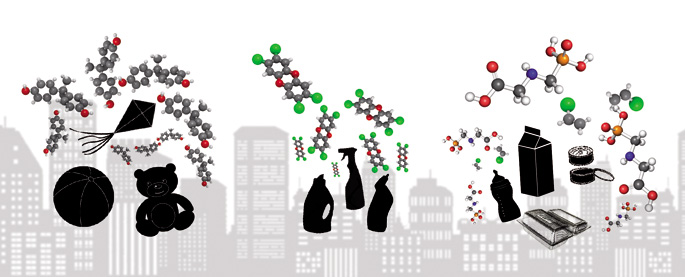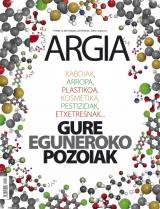Europe’s support comes late and lame
- Since the early 1990s, we've known that many of the synthetic chemicals that surround us are hormone pollutants. They trick our endocrine system and cause many diseases: reproductive disorders, cancer, diabetes... Despite the fact that scientists have long sounded the alarm, we still do not have proper regulation for this type of substance in the European Union; fortunately, not for very long. In the following lines we will tell you how the lobbies of chemicals and pesticides have managed to delay regulation. And maybe also deformation.

In recent years there has been growing public concern on the part of scientists: the concrete consequences of the interaction with the more than 100,000 chemical compounds created by human beings, especially since the Second World War, and which have been thrown into nature, are not yet sufficiently known, but there are very powerful reasons to think that they are directly related to the rise of many evils.
Since the early 1990s, it has been known that some of these compounds have a direct interaction with the endocrine systems of animals. They have many names, all of them very unsuitable for bar or table tertulia: endocrine disruptors, contaminants or hormonal disruptors…
“We have not yet found a name that could be easily disseminated among society,” explains Kistiñe García, environmental scientist Bilbaíno. García is a member of Ekologistak Martxan and his daily work is to make the blog Free of hormonal contaminants (Free of hormonal contaminants) that feeds this association. Like readers, it has given us advice to help us do the work: use the abbreviation EDC to talk about endocrine disruptors.
Endocrine “Interpreters”
As García explains, not all hormonal contaminants act in the same way, but you can basically say that they “scam” the endocrine system: they mimic hormones and the body is not able to distinguish between them. Thus, CCDs can cause dysfunctions in all hormone-regulated processes, which normally have their effect after a long period of time. Hundreds of studies have been published on the risks of endocrine disruptors in a quarter of a century since scientists' attention was drawn.
The list of diseases related to CCDs is very broad: decreased fertility, involuntary abortions, malformations in newborns, some types of cancer, obesity, allergies, diabetes, autism… The impact of these diseases has greatly increased in recent decades – see the chart on diabetes on the last page of the report – and many researchers have warned that this has a direct relation to the presence of hormonal contaminants in many of the products we use daily. Today it can be considered impossible to live without any contact with them. What's more, each of us has dozens of CCDs in his body.
They're everywhere.
In 2004, the WWF launched a campaign called Detox to evaluate substances circulating in the blood of Europeans. Personalities relevant to the analyses were selected, including fourteen ministers, who participated in the analyses. And the results were also significant: of the 103 compounds searched, 76 were detected. On average, 35 per person.
The compounds found were of all kinds: agricultural pesticides – those we get through food – polychlorinated biphenyls that are used as isolates in electrical appliances, phthalates that provide bleaching to plastics, synthetic components to smell cleaning products, fluorescent substances that are placed in sarthenes, heavy metals, some compounds that are added to clothing, components of cosmetics…
The results of that study were quite commented on, but perhaps not enough. The aim of WWF was for the European Union to tighten the legislation on synthetic chemicals that we have in the hands of consumers every day. And yes, Europe, which has long started a regulatory process, in fact a few years before WWF started the Detox campaign, has managed to delay this process enormously and, worse still, runs the risk of the outcome being founded. French journalist Stéphane Horel reported this in detail in the report A toxic affair, published in May 2015.
Officially, only suspects.
As has already been said, the risks of CVD have been known since the early 1990s. And before the end of that decade, in 1999, the European Union approved the first strategy for the research and regulation of these substances. As a result of the development over the next few years, the three European regulations at least provide for measures against hormonal pollutants and set deadlines for this. Unfortunately, these deadlines have been exhausted and the regulation on certain substances is still pending.
At best, in June of this year we will have prepared what we had long needed: Set of criteria for the regulation of substances suspected of being CSD. It has to be said that to date, officially, we have no more than suspects for lack of regulation. The list managed by the European Union contains about 500 compounds, although the number of compounds could increase to 1,500, depending on the source.
Difficult task of identifying CSD
As explained by Stéphane Horel in A toxic affair, in 2009 the European Commission entrusted the Environment Directorate with the regulation of CSDs. The management, first of all, asked for a report in order to summarize everything that science knew about endocrine pollutants. This report was prepared in 2012 under the direction of researcher Andreas Kortenkamp.
One of the main conclusions of Kortenkamp's work was the challenge of regulating CDRs, as there is no universal methodology for detecting them. We are talking about hundreds of substances, which can affect in many ways and in some cases unknown to the endocrine system, which in itself is very complex. But it is essential to be able to identify exactly what are the endocrine pollutants. In order to understand this, the regulation of chemicals in the European Union should be explained.
Is there safe space?
When regulating a chemical compound, it is assumed that it is not dangerous below a level, that is, that there is a safety margin, the distance at which contact with the substance is not harmful. However, it is accepted that some substances do not have a safety margin. The debate on CSDs focuses on whether they should be considered as substances with no safety margin.
It's impossible to live without contact with hormonal contaminants; each of us has dozens in his body.
In A toxic affair it is clear that the Kortenkamp report has for the time being determined the hormonal pollutants
which should be considered without security restrictions, as there are currently no sufficient means to detect such a possible limit in the EU. According to Kistiñe García, it would be entirely logical to classify CCDs as substances without safety margin because of the functioning of the endocrine system: “Hormones can influence very small amounts, and CCDs act in the same way as hormone imitators.”
Hormonal contaminants do not meet one of the gold standards of classical toxicology: The famous “dose that Paracelsus pronounced in the 16th century makes the poison”. Among other things, adapting to the interests of the chemical industry has turned the rule into gold, to say all. According to García, hormonal contaminants do not comply with this principle. A substance may have the greatest effect in very small doses and not so much in higher doses.
CSDs are therefore considered dangerous substances by the European pesticide legislation in force since 2009. According to it, once a compound is determined to be a hormonal contaminant, it should be banned without further delay if there is an acceptable amount of it. Of course, hormonal pollutants must first be identified; the rule states that the European Commission should develop the scientific criteria for this by 14 December 2013. After all, the Kortenkamp report called for this.
However, two and a half years later, this order has not been complied with, both in the field of pesticides – it is estimated that about 5% of those used in the world can be endocrine disruptors, according to Kistiñe García – and in the rest.
Industrial set-top
As you would expect, the chemical industry lobby and pesticides did not like the Kortenkamp report and, in general, the criteria of the European Commission’s Environment Directorate on CSDs. Many of the products they produced were threatened by the ban and began to strongly criticise the work of Kortenkamp, led by BASF and Bayer. However, they did not act alone, as they were accompanied by other departments of the European Commission and other EU Member States.
In 2011, before the Kortenkamp report was made public, Britain and Germany showed their position on disruptors in a joint statement. The regulatory system proposed by both governments for CSDs was basically based on the “power” criterion. In short, only the most powerful hormonal pollutants must be banned. Classification by power criterion became a basic demand for the chemicals and pesticide industry, although it was rejected in 2013 by experts from the Environment Directorate, then returned to the European Commission’s agenda.
The industry aims to classify hormonal pollutants according to the criterion of "potency", i.e. to ban only those with the highest capacity.
“We NGOs are fighting to ensure that this criterion is not taken into account in the regulation of CSDs that is to be adopted this year,” says Kistiñe García. Andreas Kortenkamp himself stated in the report that he bears his name that the mere use of the power criterion is not scientifically justified.
In fact, the big companies know how to bring the debate to the battlefield of science when they see their economic interest in jeopardy, and the case of hormonal pollutants has been none other. The Kortenkamp report suffered several attacks in the academic field, almost immediately after its publication. Its methodology was strongly criticised in a number of scientific articles, the authors of which were industry-related researchers, and in one case it was the British Government itself that found the work done on behalf of the Environment Directorate inappropriate.
As if it were not enough, another enemy appeared inside the house of the Directorate: In October 2012, another directorate, Health and Consumers, requested the European Food Safety Agency (EFSA) to carry out a study on the risks associated with CSDs. The request was significant due to the background of EFSA. Many hoped that this opinion would not meet the criteria defended by Andreas Kortenkamp’s team and were not mistaken, it was published in March 2013 and slipped into the industry’s arguments. It was subsequently found that half of the members of the team that studied the subject at EFSA were related to pesticide lobbies.

Next step: request for impact assessment
Despite the anti-grass roots campaign in the spring of 2013, less than a year to determine the rules, the Environment Directorate was firm in its position. In addition, I was in favour of the report just published by the UN: In the case of EDC, the UN insisted that there is no security restriction.
So, corporations took a step further: they asked for an impact assessment. Such evaluations take a long time and their aim is to foresee the positive and negative consequences of a policy proposed by the European Commission. Including economic effects. In addition to the request, the chemical industry lobby submitted a number of reports indicating the economic damage that a possible ban on CSD would entail.
According to Stéphane Horel, with the request for an impact assessment, the industry expected to gain time. At the same time, it did not want to waste the opportunity to use the negotiations of the free trade agreement TTIP, which were about to start at that time. In this regard, European owners were supported by other transatlantic companies: the large US chemical and pesticide companies informed the EU authorities of their “great concern” over the European CDR criteria. In his view, the application of criteria so different from those of URL0. would hinder trade, “precisely the obstacles that are intended to be removed through the agreement that the EU and the US intend to negotiate.
By mid-2013, the European Commission approved an evaluation impact that made it impossible to meet the deadlines set by the pesticide legislation. Over time, the lobbies restarted their struggle in the scientific field and, finally, succeeded: In 2014, the roadmap proposed by the Environment Directorate for the identification of CSDs lost priority and, as we have already said, the power criterion advocated by the industry reappeared. Everything would be completed shortly afterwards with the creation of the new European Commission under the mandate of Jean-Claude Juncker. New Commissioners were appointed and the roles of each department were redefined. Since then, leadership on the regulatory criteria of CCDs is not in the hands of the Environment Directorate, which now has the honour of being the Health and Consumer Directorate, more focused on the wishes of the industry.
The last batch, a priori
We have reached the spring of 2016 without identification criteria for CSDs that should have been decided in 2013. Since the publication of A toxic affair, only one thing has changed, but not of minor importance: In 2014, Sweden filed a complaint against the European Commission before the European Court of Justice for ‘lapse’ on the subject of the EDC regulation, and in January 2015, unexpectedly, both Parliament and the European Council decided to adhere to that complaint. In December last year, the Court gave the plaintiffs the right to do so. The EU must therefore abandon the economic criteria and create regulations with strictly scientific criteria for hormonal pollutants on the orders of a judge. It remains to be seen whether that will be enough for Europeans to start building adequate protection.
Apirilaren 7an, Osasunaren Munduko Egunean, datu beldurgarria zabaldu zuen Osasunaren Munduko Erakundeak (OME): 422 milioi diabetes gaixo dago munduan –biztanleria osoaren %8,5–; 1980ko kopurua halako lau. Eta datozen hogei urteetan zifra bikoiztuko dela uste da. Odoleko glukosa kantitate handiak 3,7 milioi heriotzaren kasua izan ziren 2012an; horietatik 1,5 milioi zuzenean diabetesak eragindakoak.
Gaitzaren zabalkunde izugarri hori loditasunaren gorakadari egotzi dio OMEk, biztanleria zahartzearekin batera. Baina Kistiñe Garcia Ekologistak Martxaneko kidearen ustez, ezin daitezke aipatu gabe utzi diabetesa kutsatzaile hormonalekin lotzen duten gero eta ikerlan ugariagoak. Zehazki, bizitzaren hasieran –eta bereziki umea oraindik jaio gabe dagoenean– zenbait EDCrekiko harremana izateak gerora diabetesa garatzea erraztu lezake. Bestalde, kutsatzaile hormonalak izan litezke loditasunaren gorakadaren zergatietako bat. 2014an 30 zientzialarik sinatutako Parmako Adierazpenaren arabera, substantzia mota horiek zerikusia dute loditasuna, diabetesa eta beste nahasmendu metaboliko batzuekin, batez ere haiekiko harremana haurtzaroan gertatzen denean. Gero eta mediku eta zientzialari gehiagok esaten du harreman hori ahal den heinean gutxitzea prebentzio politiken parte izan behar dela.
2015eko maiatzean, Danimarkako Coop Danmark supermerkatu-kateak iragarri zuen ez zuela gehiago salduko mikrouhin-labean berotzeko krispeta poltsarik bere dendetan. Horren arrazoia zen enpresako arduradunek ez zutela aurkitu kutsatzaile hormonalik gabeko poltsarik merkatuan.
Krispeta-poltsek fluordun substantziak eduki ohi dituzte. Substantzia horiei esker ontziek mikrouhin-labeetako beroa jasan dezakete, eta ohikoak dira tenperatura altuen pean egoten diren artikuluetan. Krispeta-poltsetan ez ezik, zartaginetan, pizza kutxetan... aurkituko dituzu. Ikerketa askok erakutsi dute kutsatzaile hormonalak direla eta besteak beste nahigabeko abortuak eta ugalkortasun galera eragin dezaketela.
Artikulu askoren kasuan kutsatzailerik gabeko alternatibak dauden arren, Coop Danmark ez zen gai izan EDCrik gabeko krispeta-poltsarik aurkitzeko; hortaz, produktua bere dendetatik kentzea erabaki zuen, bezeroen osasunaren onerako. Izan ere, supermerkatu-kateak kontsumitzaileak babesteko estrategia abiarazi du: zientzia ikerlanen arabera arriskutsuak izan daitezkeen zenbait substantzia identifikatu ditu, eta 2017rako erabat kenduko ditu apaletatik. “Jende askok uste du legezkoa dena segurua dela, baina ez du beti zertan hala izan”, adierazi zuen enpresak, krispetarik ez saltzeko neurriaren berri eman zuenean, “zientzialariek kezka agertzen dutenetik araudia ezartzen den arte bost edo hamar urte igaro daitezke”.
Azkenean, Coop Danmark-eko dendetan hilabete gutxi batzuk baino ez zuen iraun krispeta-poltsek utzitako hutsunea, Liven izeneko enpresa katalan batek kutsatzaile hormonalik gabeko poltsak sortu zituela iragarri baitzuen urrian.
Estrasburgon egindako saioan, Eurolegebiltzarrak ezetz esan dio kutsatzaile hormonalak definitzeko Europako Batzordeak –saiakera askoren ostean– aurkeztutako irizpide sortari. Batzordearen testuak zientzialari ugariren kritikak jaso ditu, hala nola Europa osoko... [+]
Irailaren 25etik 28ra egingo da, Bilboko Mediku Zientzia Akademiak antolatuta, Medikuntza Astearen 44. edizioa. Aurtengo goiburua Osasuna eta kutsadura: Epidemia isila da. Lehenbiziko hizlaria Nicolás Olea Granadako Unibertsitateko medikuntza katedraduna eta disrupzio... [+]
Europako Legebiltzarrak eskatu du elikagaiak gordetzeko ontzi guztietan A bisfenol izeneko konposatua debeka dadila. Era berean, elikagaien ontziratzean erabiltzen diren substantzia kimikoak zorrotzago arautzea galdatu dute europarlamentariek.
Ekologistak Martxan elkarteak jakinarazi du Espainiako Estatuan herritarrek kontsumitzen dituzten fruitu eta barazkiek beren mamian daramatzatela gutxienez 33 disruptore endokrino, gizakiei gaixotasun larriak eragiten dituztenak. Hamar elikagai kutsatuenen taula ikusgarria ere... [+]


















